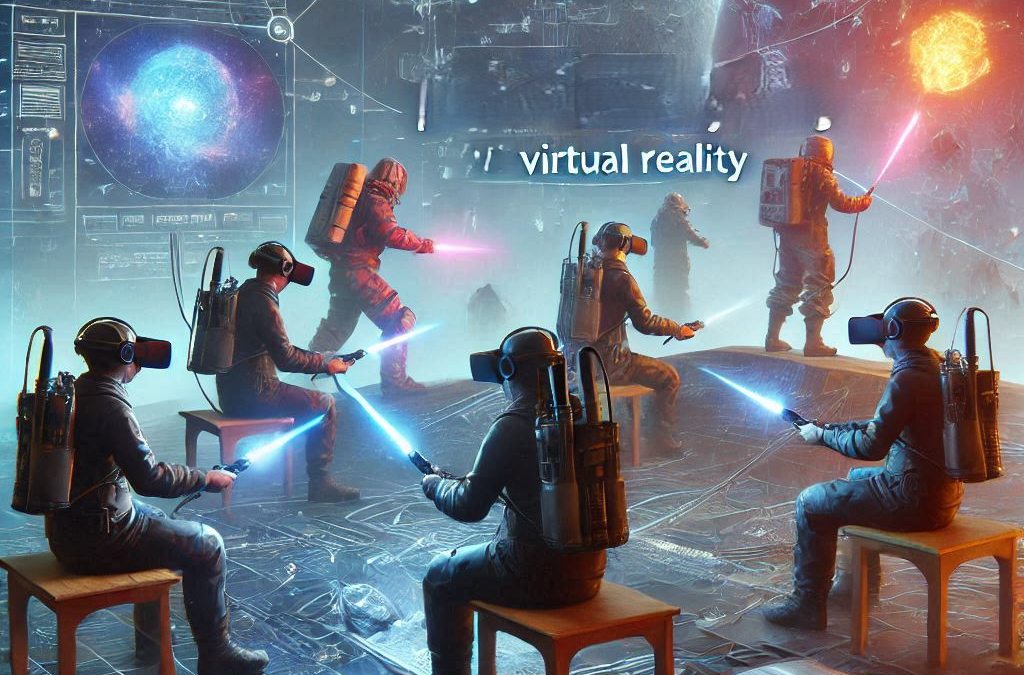Multiplayer procedural storytelling in virtual reality will mold the future of immersive experiences.
Every phase in gaming development is interlinked with crossing the next boundary: from pixelated screens’ simplicity to visual splendor and the expansive open worlds that games sport today. And each stride has reframed how one entertains oneself. So here is Virtual Reality, in which games literally place gamers right inside their surroundings.
Among many such developments in VR, it is this concept of multi-player procedural storytelling that becomes revolutionary: it is through this concept that one achieves real-time dynamic narratives based upon the choices of the players—an approach leading to endless replays and deep personal experiences. Here, the opportunities among investors and businesses are multifold as this opens one gateway to transformational experiences in gaming, making it an ideal time for hiring a game developer to bring these visionary concepts to life.
The Fusion of Multiplayer and Procedural Storytelling
Traditional game narratives are very linear because a pre-existing storyline takes players from one scene to another. Such a storyline might lead to great, scripted moments but generally doesn’t provide room for players’ choice and creativity. Algorithmic generation of narratives breaks those bounds, allowing the procedural narrative to be something that players and game designers can experiment with. If combined with multiplayer functionality, it could become a shared, constantly evolving tapestry shaped by each participant’s decisions. Procedural storytelling simply means that no two sessions will be alike in a multiplayer VR environment. Each of the player’s choices—to form an alliance with another character, to go into an ominous cave, or to betray the teammate—resonates and ripples out to shape the story of everyone. Dynamic tales are not stories alone; they are living experiences, reacting to the decisions made by the players, ensuring each session is a new adventure.
Transmutation of Immersion: The Role of VR
Procedural storytelling becomes tangibly real with Virtual Reality. Instead of watching a story play out on the screen, a player is there, physically present within the world of the story. As the player plays this medium, the intensely involved feeling within VR cranks up the stakes that decisions made by the players hold: everything matters. Imagine yourself standing in a virtual medieval kingdom with your team, deciding whether or not to execute a spy they’ve captured.
The weight of that decision—and the consequences that follow—becomes much more impactful when experienced in VR.
The real-time nature of VR multiplayer experiences also fosters collaboration and competition among players. In a procedurally generated narrative, alliances may form to overcome a common enemy, only to dissolve later due to conflicting interests. Such dynamics create a tapestry of interactions that can be felt as authentic and very engaging.
Unlimited Replayability: A Golden Ticket Ends
Replayability has always been one of the key factors to success in a game. Procedurally generated narratives mean that VR games can present virtually infinite possibilities. Players can go through the same virtual world multiple times and encounter completely different storylines, characters, and challenges based on their decisions and those of their peers.
This endless variety will make long-term engagement with players absolutely sure and an important attractor, not just for gamers, but for investors as well. While the majority of other games could become dull after one or two passes through, VR games with procedural storytelling never get old, thereby opening paths for subscription models, expansions, and community-driven content-a sure way towards the steady inflow of funds.
The technological base.
It uses the advanced technologies to create procedural multiplayer storytelling in VR. It is also influenced highly by AI for the real-time generation of storylines, dialogues, and even interaction between characters. NLP ensures that the NPCs react as if they are responding to the actions of the player appropriately, and machine learning enhances the system to change it over time.
Multiplayer infrastructure should be equally strong to enable true, in-game real-time decisions between different gamers. For the synchrony of such experiences within a VR setting, connectivity should have minimal latency while using complex architectures in the server aspect. People who are doing these kinds of jobs are making not only games but revolutionizing new media interactive productions which would fuse story artistry and socializing features together.
Why investors should take notice
The market potential for VR games with multiplayer procedural storytelling is huge. Improvements in hardware, decreased costs, and increasing consumer interest are all expected to lead to exponential growth in the global VR gaming market in the coming years. Investing in this innovative segment positions stakeholders at the forefront of a rapidly expanding industry.
The VR procedurally generated experiences are scalable in nature. In one game, there could be thousands of diverse narratives, thus reducing new releases while maintaining player interests. It translates to cost efficiency and higher margins. The social aspect that multiplayer VR brings about leads to community building, creates brand loyalty, and drives word-of-mouth marketing.
This is the most opportune time for firms looking to hire virtual reality developer to make such an investment. A good VR developer can come up with very immersive environments and implement procedural storytelling mechanics in the software and optimize multiplayer experiences; when such innovative minds are aboard, a business can come up with some flagship titles that redefine gaming.
The Future of Multi-Player Procedural Story Telling More mature technology could take it beyond an infinite multitude. That science fiction universe, imagining people traveling to newly opened planets, making treaties among alien species, or to further the course of intergalactic politics, is at an individual’s disposal. That may sound vague when someone discusses choices shaping not only some personal journey but one affecting the entire shared universea truly dynamic ecosystem. And, indeed, even more sophistication in AI may allow for even more complex storytelling. For instance, characters may remember all their encounters with players and develop complex relationships over time. These would blur the line between scripted stories and emergent gameplay, experiences that really feel alive.
Conclusion: A Call to Action for Investors
This is the tipping point of where the whole convergence of multiplayer functionality, procedural storytelling, and VR all comes together in order to be that transformative leap for the gaming industry. Such technology offers dynamic, personalized stories evolving with every player choice for unprecedented engagement and replay value that’s never-ending. This isn’t just about participation in a growing market for investors but about contributing to shaping the future of entertainment.
First things first, finding a VR games developer is going to be the step to achieving these revolutionary experiences. With a good investment in talent and technologies, businesses will find themselves leading the curve in this new, innovative territory. Multiplayer procedural storytelling in VR is not a trend but a view into a future of interactive entertainment. The question is not when this revolution is going to happen but who it will be led by. Will it be you?






